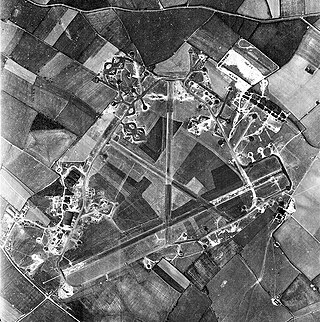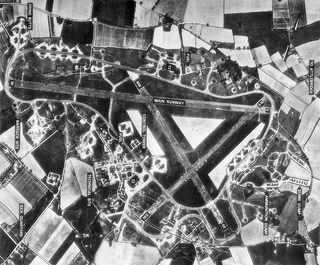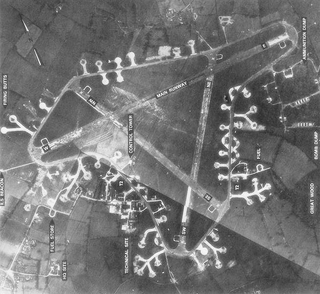
Royal Air Force Chelveston or more simply RAF Chelveston is a former Royal Air Force station located on the south side of the B645, 5 miles (8.0 km) east of Wellingborough, near the village of Chelveston in Northamptonshire, England. During the Second World War the airfield was occupied by both the Royal Air Force and the United States Army Air Forces. It was given the USAAF designation Station 105.

Royal Air Force Podington, more commonly known as RAF Podington, is a former Royal Air Force (RAF) station in northern Bedfordshire, England, 6 miles south-east of Wellingborough, Northamptonshire.

Royal Air Force North Pickenham or more simply RAF North Pickenham is a former Royal Air Force station located 3 miles (4.8 km) East of Swaffham, Norfolk, England.

Royal Air Force Ridgewell or more simply RAF Ridgewell is a former Royal Air Force station located at Ridgewell, 7.5 miles (12.1 km) north west of Halstead, Essex, England.

Royal Air Force Harrington or more simply RAF Harrington is a former Royal Air Force station in England about 5.6 miles (9.0 km) west of Kettering in Northamptonshire south of the village of Harrington off the A14 road. During the early Cold War, it was a Thor missile site, designed to deliver atomic warheads to the Soviet Union. The nuclear missile site is now protected as a Grade II listed building as an example of Cold War architecture.

Royal Air Force Hethel or more simply RAF Hethel is a former Royal Air Force station which was used by both the United States Army Air Forces (USAAF) and the Royal Air Force (RAF) during the Second World War. The airfield is located 7 miles (11 km) south west of Norwich, Norfolk, England and is now owned by Lotus Cars.

Royal Air Force Tibenham or more simply RAF Tibenham is a former Royal Air Force station located 13.5 miles (21.7 km) southwest of Norwich and 5.8 miles (9.3 km) north of Diss, Norfolk, England.

Royal Air Force Wendling or RAF Wendling is a former Royal Air Force station located 4 miles (6.4 km) north west of East Dereham, Norfolk, England.

Royal Air Force Mendlesham, or more simply RAF Mendlesham, is a former Royal Air Force station located 5.5 miles (8.9 km) east of Stowmarket, Suffolk, England.

Royal Air Force Eye or more simply RAF Eye is a former Royal Air Force station located 11 miles (18 km) northeast of Stowmarket, Suffolk, England on the northwest edge of Eye and south of Diss.

Royal Air Force Debach or more simply RAF Debach is a former Royal Air Force station located at Debach, 3 miles (4.8 km) northwest of Woodbridge, Suffolk, England.

Royal Air Force Bungay or more simply RAF Bungay is a former Royal Air Force station located 3 miles (4.8 km) south-west of Bungay in the English county of Suffolk.

Royal Air Force Seething, or more simply RAF Seething , is a former Royal Air Force station located around 9 NM south-east of Norwich, Norfolk, England. The base was located on the parish boundaries of Seething, Mundham and Hedenham.

Royal Air Force Halesworth or more simply RAF Halesworth is a former Royal Air Force station located 2 miles (3 km) north east of the town of Halesworth, Suffolk, England and 7 miles (11 km) west of Southwold.

Royal Air Force Attlebridge, or simply RAF Attlebridge, is a former Royal Air Force station located near Attlebridge and 8 miles (13 km) northwest of Norwich, Norfolk, England.

Royal Air Force Thorpe Abbotts or more simply RAF Thorpe Abbotts is a former Royal Air Force station located 4 miles (6.4 km) east of Diss, Norfolk, in eastern England.

Royal Air Force Framlingham or more simply RAF Framlingham is a former Royal Air Force station located 3 miles (4.8 km) southeast of Framlingham, Suffolk, England.

Royal Air Force Sudbury or more simply RAF Sudbury is a former Royal Air Force station located 2 miles (3.2 km) north-east of Sudbury, Suffolk, England.

Royal Air Force Andrews Field or more simply RAF Andrews Field is a former Royal Air Force station located 4 miles (6.4 km) east-northeast of Great Dunmow Essex, England.

The 467th Bombardment Group is an inactive United States Army Air Forces unit. Its last assignment was to the Strategic Air Command, being stationed at Clovis Army Airfield, New Mexico. It was inactivated on 4 August 1946.





























